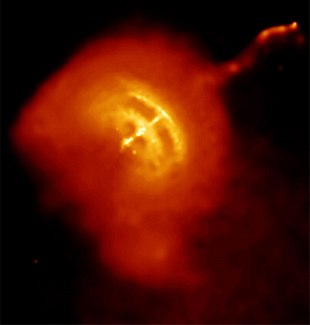PSR B0833-45
|
Pulsar PSR B0833-45 (Vela Pulsar) |
||||||||||||
|---|---|---|---|---|---|---|---|---|---|---|---|---|

|
||||||||||||
| Vela Pulsar is the bright point in the middle, surrounded by a pulsar wind nebula , in which plasma shock waves and radial jets can be seen. | ||||||||||||
|
Observation dates equinox : J2000.0 , epoch : J2000.0 |
||||||||||||
| Constellation | Sails of the ship | |||||||||||
| Right ascension | 08 h 35 m 20.66 s | |||||||||||
| declination | −45 ° 10 ′ 35.2 ″ | |||||||||||
| Astrometry | ||||||||||||
| distance |
Lj pc |
|||||||||||
| Physical Properties | ||||||||||||
|
Other names and catalog entries |
||||||||||||
|
||||||||||||
| Aladin previewer | ||||||||||||
The pulsar PSR B0833-45 , also known as the Vela pulsar , is located in the constellation of the ship's sails . It was discovered in 1968. In 1977 it was one of the few pulsars to be identified as a remnant of a supernova in the optical range . It is parsec (936 light years ) away. It comes from the Vela supernova ; it is spatially closest that could be determined from the known remains of the past 50,000 years. The period of rotation of the pulsar is 89 ms, its increase 10.7 ns per day. This results in a very young age of around 11,000 years.

The Vela pulsar not only radiates in the visible and microwave range, but is also one of the strongest gamma radiation sources in the sky. The spectrum corresponds to that of a thermal black-body radiator with a temperature of from 600,000 to 1,000,000 K .
At around 800 light years, the Vela pulsar and Geminga are roughly the same distance from Earth, making them the two closest known pulsars.
Web links
Individual evidence
- ↑ Vela Pulsar. In: SIMBAD . Center de Données astronomiques de Strasbourg , accessed on October 19, 2019 .
- ↑ a b R. Dodson, D. Legge, JE Reynolds, PM McCulloch: The Vela Pulsar's Proper Motion and Parallax Derived from VLBI Observations . In: Astrophysical Journal . tape 596 , no. 2 , 2003, p. 1137–1141 , bibcode : 2003ApJ ... 596.1137D .

